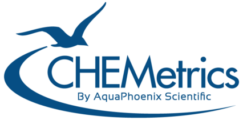Monochloramine Test Kits
What is Monochloramine?
Chloramines are a group of chemical compounds that contain ammonia and chlorine. Monochloramine (NH2Cl) is the simplest chemical compound of the chloramine group and as a result is often referred to as “chloramine.”
Monochloramine is a colorless liquid that is soluble in water. It is commonly added to drinking water to function as a secondary disinfectant in a process called chloramination.
Monochloramine is formed by the reaction of free ammonia (NH3 and NH4+) with free chlorine. Dichloramine (NHCl2) and trichloramine (NCl3) will also form if free chlorine remains in solution after all free ammonia has been converted to monochloramine. Dichloramine and trichloramine are less effective at disinfection and impart an unpleasant odor to the water. Therefore, chloramination processes are optimized for monochloramine production.
Visual Kits
| Range | MDL | Method | Kit Catalog No. | Refill Catalog No. |
|---|---|---|---|---|
| 0 - 20 ppm as NH2Cl-Cl2 | 0.625 ppm | Hydroxybenzyl Alcohol (HBA) | K-6802 | R-1402 |
Instrumental Kits
| Range | Method | Kit Catalog No. |
|---|---|---|
| V-2000: 0 - 15.0 ppm, V-3000 & Spec: 0 - 8.00 ppm as NH2Cl-Cl2 | Hydroxybenzyl Alcohol (HBA) | K-6803 |
Methods
Monochloramine reacts with hydroxybenzyl alcohol (HBA), in the presence of sodium nitroferricyanide, to form a green colored complex. This test method measures monochloramine only. Results are expressed in ppm (mg/L) monochloramine as chlorine, NH2Cl-Cl2.
CHEMetrics offers ammonia test kits employing the HBA chemistry that can be used to determine free ammonia concentration in the presence of monochloramine using the following test procedures: K-1413 and K-1420.
Method References: Krom, Michael D., Spectrophotometric Determination of Ammonia: A study of a
Modified Berthelot Reduction Using Salicylate and Dichloroisocyanurate, The
Analyst, V105 pp. 305-316, 1980.

